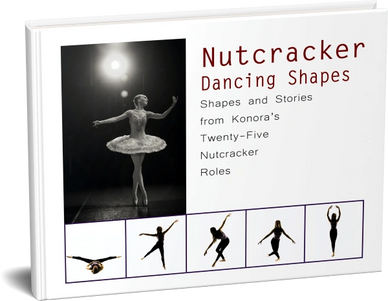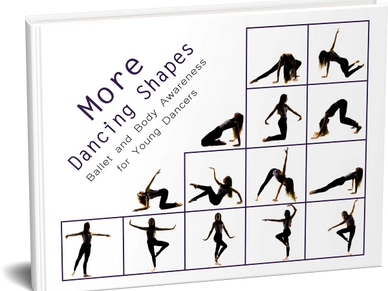Dancing Shapes: Ballet and Body Awareness for Young Dancers
Dancing Shapes

Nutcracker Dancing Shapes

More Dancing Shapes

Dancing Shapes with Attitude

Dancing Shapes with Cats (Coming soon)
Dancing Shapes with Cats (Coming soon)
Dancing Shapes (Ages 6+)
A pandemic-inspired narrative about how dance can be enjoyed in any setting.
• A Gorgeous Glimpse into Ballerina Konora’s Journey
• Learn Ballet Technique
• Explore Concepts Related to Dance

Nutcracker Dancing Shapes (Ages 7+)
Discover the Story
Reminisce with Konora
Explore Storytelling

Explore Storytelling
Reminisce with Konora
Explore Storytelling

Reminisce with Konora
Reminisce with Konora

Learn Ballet Technique
Learn some Fancy French

Analyze details
Learn some Fancy French
Learn some Fancy French

Learn some Fancy French
Learn some Fancy French
Learn some Fancy French

More Dancing Shapes (Ages 7+)
Our ballerina heroine, Konora, leads readers through:
• An Inside Glimpse into her Continuing Almost-Ballerina Journey
• Warm-Up and Basic Ballet Technique Lesson
• An Exploration of Form and Shape
• Creating their Own Unique Shapes

Dancing Shapes with Attitude (8+)
Catch up on Konora's Journey
Straight talk on subjectivity
Catch up on Konora's Journey

"heartfelt and detailed"
Straight talk on subjectivity
Catch up on Konora's Journey

Straight talk on subjectivity
Straight talk on subjectivity
Straight talk on subjectivity

Learn Ballet Terminoloty
Learn Ballet Terminoloty
Straight talk on subjectivity

Learn Ballet Technique
Learn Ballet Terminoloty
Learn Ballet Technique

Think about Details
Learn Ballet Terminoloty
Learn Ballet Technique

Dancing Shapes Reviews
A lovely book for young dancers that encourages hopefulness, creativity and new movement...
A lovely book for young dancers that encourages hopefulness, creativity and new movement...
A lovely book for young dancers that encourages hopefulness, creativity and new movement...
Dancing Shapes is a unique book for young dancers. Deriving directly from the pandemic time, Dancing Shapes captures both resilient hope and the power of imagination. Konora shares her path, from training as a young student, through performing professionally. It's a path that is familiar to some and interesting to many. Konora also shares how anyone, anywhere, can use the transformative power of their imaginations as professional dancers do, which is an important, inclusive message- everyone can explore movement creatively and imaginatively. Some basic ballet positions are described and shown in pictures, with visual and mental imagery to help young dancers understand the qualitative feelings of the positions. My favorite part of the book is the last section, "Thinking About Details", as it encourages individual thought and expression. Emphasizing how body parts can be used to find different shapes (ie. the many shapes the fingers and hands can create), this book can stimulate new movement patterns that extend beyond those that are habitual in everyday life, or even in early ballet training.
(Anonymous on Amazon)
This is a visually stunning and interactive book that will inspire young dancers...
A lovely book for young dancers that encourages hopefulness, creativity and new movement...
A lovely book for young dancers that encourages hopefulness, creativity and new movement...
...Easily the most compelling component of this book is its visuals, beginning on the cover and dominating each page. Full color photographs of Konora in costume inspire children to dream of being a professional ballerina. Myriad photographs also feature Konora backlit to focus on her body position instead of what she is wearing. Dynamic body shapes can be challenging to replicate, but the presentation is accessible to children regardless of their abilities.
Young dancers will love having this reference at hand even once dance classes open again. Especially because this book teaches routines and practices to keep moving bodies safe, it is an important addition to a young ballet dancer’s home library.
(Mary Lanni on Reedsy)
...A superb tool for young dancers...
A lovely book for young dancers that encourages hopefulness, creativity and new movement...
...A superb tool for young dancers...
"With constant support and innovative descriptions that will spark imaginations, Konora invites readers to share the joy of dancing. A superb tool for young dancers, full of accessible poses to mimic."
-Kirkus Reviews
Nutcracker Dancing Shapes Review
This natural extension of the Dancing Shapes series is a delight for ballet dancers who love The Nutcracker story.
Perhaps one of the most iconic performances of the holiday season is The Nutcracker, a story told through dance by both amateur and professional dance companies alike. In this third installment of the Dancing Shapes series, readers get a backstage tour of many of the twenty-five Nutcracker roles ballerina Konora has played throughout her life.
Like the other books in this series, Konora is featured throughout the book in both the narrative and in the abundance of photographic images. While most of the pictures are of Konora in costume, a few have her backlit as she is demonstrating certain shapes for the reader. These pictures are inspiring to dancers of all ages, especially because each pose can be studied and mirrored with practice.
A table of contents at the beginning of the book gives readers an idea of what to expect and helps them navigate to the sections that are of the most interest to them. This book includes more of a narrative than the others in the series, but there are invitations for the reader to interact, as well. In addition to a warm-up like those found in the other Dancing Shapes books, Konora includes an entire section devoted to The Nutcracker story and the many variations found in performances across the United States. Even readers familiar with The Nutcracker will learn something new!
As in the other books in this series, the storytelling in this book speaks directly to the reader. Invitations to participate are found alongside commentary about Konora’s dancing experience, all of which encourage dancers to work hard and keep trying even when challenges arise. Because of the amount of text, this book is best read by a confident older child or adult caregiver. A small glossary of terms at the end of the book assists with pronunciation of some of the French words and phrases used in the story.
This book is a natural extension of the Dancing Shapes series and builds upon the skills learned in the first two installments. Fans of Konora and her teaching style will love adding this story to their shelves.
—Mary Lanni on Reedsy
More Dancing Shapes Review
This is a natural extension of the Dancing Shapes series and is an interactive addition to young ballet dancers’ reading collections.
Ballerina Konora is back with even more dancing shapes to share. Sidelined by the coronavirus pandemic, Konora and her mother turned to creating books for young and aspiring dancers to support movement and the learning of dance from home.
Like the first book in the series, More Dancing Shapes begins with an introduction speaking directly to readers and informing them how the book is designed and intended to be used. After a brief description of Konora’s dancing history—including new details not mentioned in the first installment—readers are invited to get up and move along with Konora. Beginning with a warm up, young dancers learn new ballet terms and movements, enhancing their repertoire and building upon skills learned in the first book.
Vivid photographs appear on every page, inspiring and demonstrating at the same time. Whether onstage in a bright costume or backlit to showcase a particular shape, these images of Konora are compelling to both dancers and non-dancers alike.
This book incorporates more French ballet terminology than its predecessor, elevating young dancers to the next level of understanding. An informal glossary of terms at the end of the book helps with pronunciation and comprehension in case context is not sufficient for some readers.
An actively engaging game is included in this book, encouraging creativity as readers attempt to follow Konora’s prompts in their own way. Imagination is a common theme in this book, and readers are even invited to share their stories with Konora directly, if they wish.
Like the first book, this second installment emphasizes the fact that dancing is for everyone, whether performing onstage or moving purely for enjoyment. A balanced amount of text and imagery makes this book accessible to a range of readers, although the text itself is best read aloud by an adult due to its complexity.
Written in a conversational tone that speaks directly to readers, this is a natural extension of the Dancing Shapes series and is an interactive addition to young ballet dancers’ reading collections.
—Mary Lanni, Reedsy

Dancing Shapes with Attitude Review
A heartfelt and detailed non-fiction story that teaches ballet movements while reminding readers to be kind in a subjective world.
The life of a dancer is rarely predictable, and because dance is a subjective art form, it can be difficult for any dancer to face competition or criticism. Ballerina Konora is back in the newest addition to the Dancing Shapes series. Here, she gets personal with readers and explains some of the dimmer moments of her dancing career. As she anxiously awaits an update on where she will be performing next, Konora introduces readers to more complicated dancing shapes than in the other installments. As readers become ready for more of a challenge, this book provides one, along with the reminder that everyone sees something different when they observe art.
Like the others in the Dancing Shapes series, this book begins with a narrative before transitioning into the movement portion. This book gets more personal with readers than the other stories as it highlights moments of disappointment and how Konora has overcome them throughout her dancing career. Competitive and performing dancers of all types will recognize the emotions mentioned in this book and will find a kindred spirit in Konora.
Dynamic photographs of Konora in action are the visual feature of this book, like in the previous books. In addition to back-lit, black-and-white images are ones of Konora against surprising and compelling backdrops. Each picture gives readers a sense that dance and movement are intrinsic elements of life everywhere.
The instructional section of this book focuses on attitude and arabesque. These movements are described in great detail, giving readers the tools they need to execute each one accurately. Readers who appreciate getting into the important, nuanced pieces of ballet shapes will relish the approach to teaching these two movements.
At the end of the book, readers are left with a teaser to learn where Konora will be performing next along with a reminder to be kind—both to one another and to themselves. Once Upon a Dance reiterates the message that dancing truly is for everybody, and this book makes that fact especially obvious. Dancers with an interest in leveling up their dancing ability will love adding this book to their libraries and practicing the skills it teaches.
—Mary Lanni on Reedsy